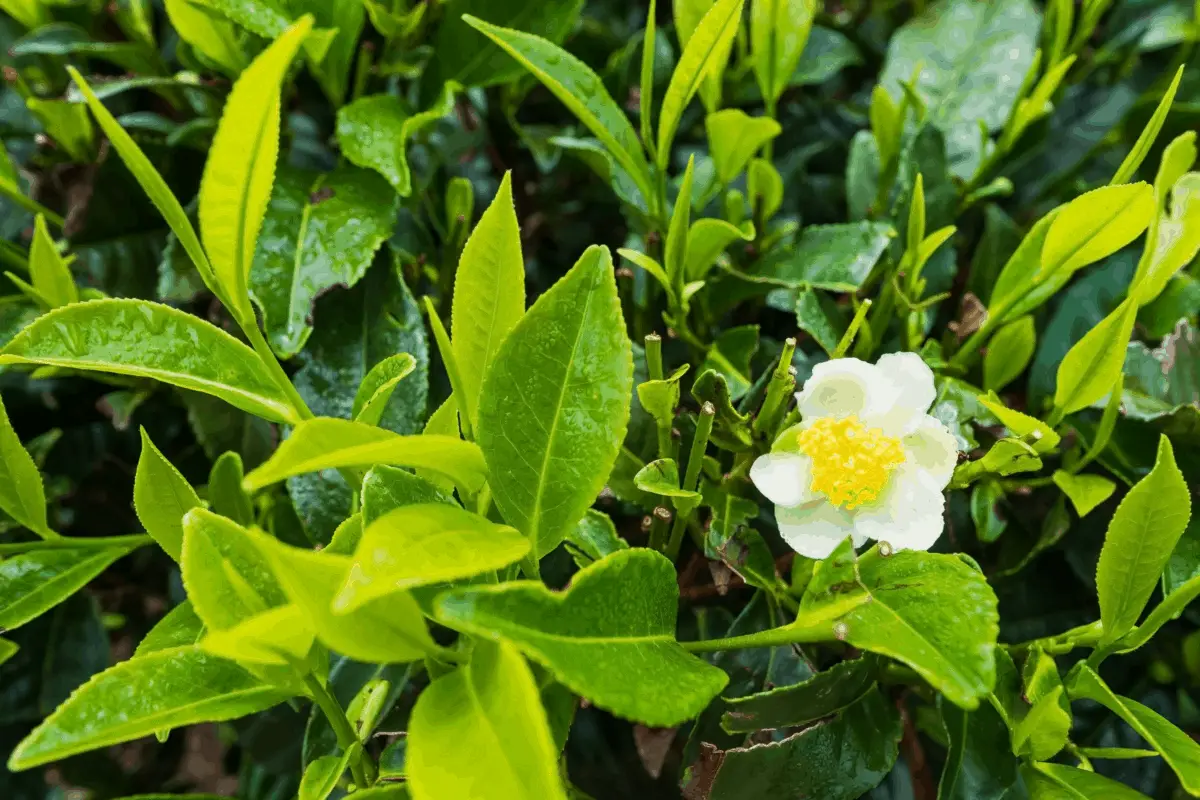As a tea enthusiast, you already know that your true teas are all cultivated from the Camellia sinensis plant. In addition, if you are anything like me and often take on interesting DIY projects, you might be interested in growing your own tea plant. Did you know that growing Camellia sinensis in your own home is possible? With the help of this step-by-step guide, you can master the art of growing this specific broadleaf evergreen shrub indoors. Let’s get started.
To grow Camellia sinensis, you will need to soak and germinate the seeds, plant in acidic soil, grow and cultivate the shrub, and finally harvest and sun-dry the leaves for making tea. Water daily in a self-draining pot. To grow well, Camellia sinensis needs a warm, shady spot away from direct sunlight.
This article will serve as a step-by-step guide to the art of growing Camellia sinensis in your house.
You will learn how to prepare the seeds and plant them in a pot properly. Moreover, you will also learn how to take care of the plant on a daily basis, and how to cultivate and harvest it for tea leaves.
How Can You Grow Camellia Sinensis in Your Home?
You can always purchase your favorite brand of tea from the local shop. However, there is certain happiness, joy, and comfort in growing your own tea in your home.

This way, you can have a wide array of choices for making tea at your fingertips, such as:
- Black Tea
- Oolong Tea
- Green Tea
Moreover, you can supervise every single phase of the process by yourself. The next section of this article will detail the steps to start growing Camellia sinensis in your home.
“To grow Camellia sinensis, you will need to soak and germinate the seeds, plant in acidic soil, grow and cultivate the shrub, and finally harvest and sun-dry the leaves for making tea. Water daily in a self-draining pot. To grow well, Camellia sinensis needs a warm, shady spot away from direct sunlight.”
TEA CROSSING
What Supplies Will You Need to Grow Camellia Sinensis Indoors?
First things first. As with any project, growing your own perennial tea plant in your own home requires a few supplies.

You will require the following things:
- Camellia sinensis seeds from a reputable, preferably organic source
- Appropriate pots
- Acidic soil for pots
- Acidic plant fertilizer
- Pruning shears for trimming
On the other hand, you can also buy custom made plant growing kits from the market and have all the tools you may need to grow Camellia sinensis indoors.
Steps for Growing Camellia Sinensis: 6 Steps
While growing your own tea plant might sound exotic and potentially difficult, the reality is that Camellia sinensis is simply a perennial shrub.
The shrub itself is fairly hardy and easy to grow. The trick is to grow it in a way that results in leaves appropriate for tea.
In this case, the much-loved evergreen shrub needs a warm location protected from direct sunlight. Your home might just be the perfect location, and growing it indoors is always an option.

Let’s cover the essential steps for growing your own tea plant.
Step #1: Purchase the Seeds
The best and the most recommended tea seeds are always Camellia sinensis. There is a reason for this. These plants offer a wide range of harvesting choices, and you can make several kinds of tea from these plants.
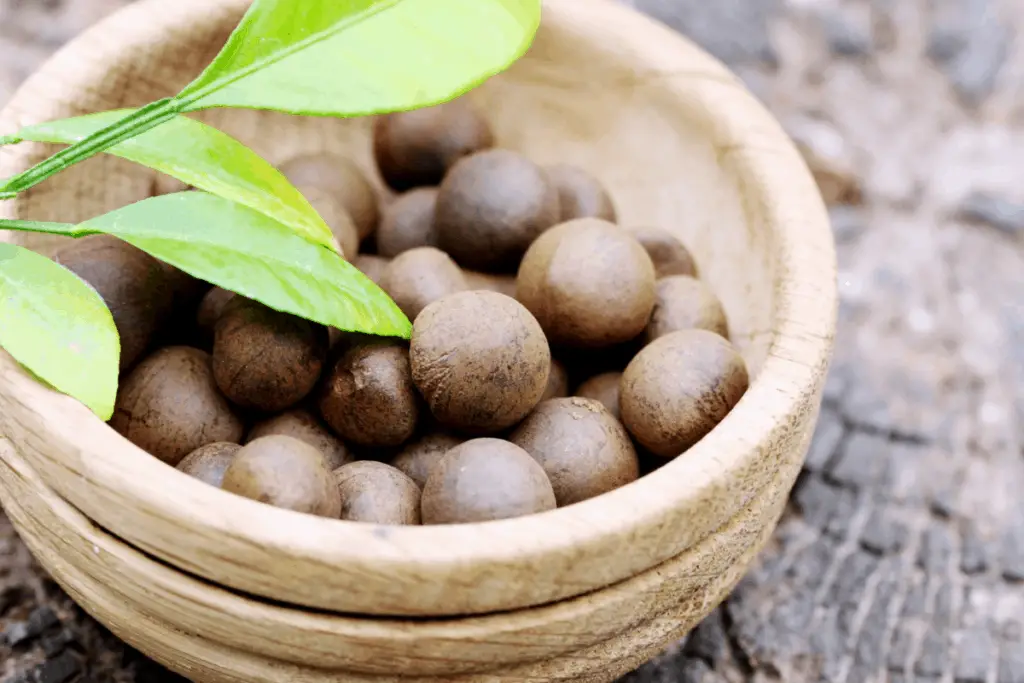
You can also use pre-grown plants from the nursery or cut down stalks from existing plants and nurture them into shrubs.
However, professionals recommend using seeds, so you have more control over the process of germinating the seeds and supervising the entire process from the very beginning.
Step #2: Soak the Seeds Properly
Once you have decided upon the seeds and you have bought them, the next step is to soak the seeds in a bowl of water. Make sure that when you are soaking the seeds, they are completely submerged and underwater, and you should let them soak for at least two days before moving onto the next stage.
You need to let the seeds absorb sufficient water in 48 hours. The reason behind soaking the seeds is to speed up the entire process of germinating the seeds in the next step.
Step #3: Germinate the Seeds for 8 Weeks
The next step is to start germinating the seeds. You need to take out the soaked seeds and place them into different containers. You need to make sure that you only put two to three seeds in every container and fill up containers with damp soil.
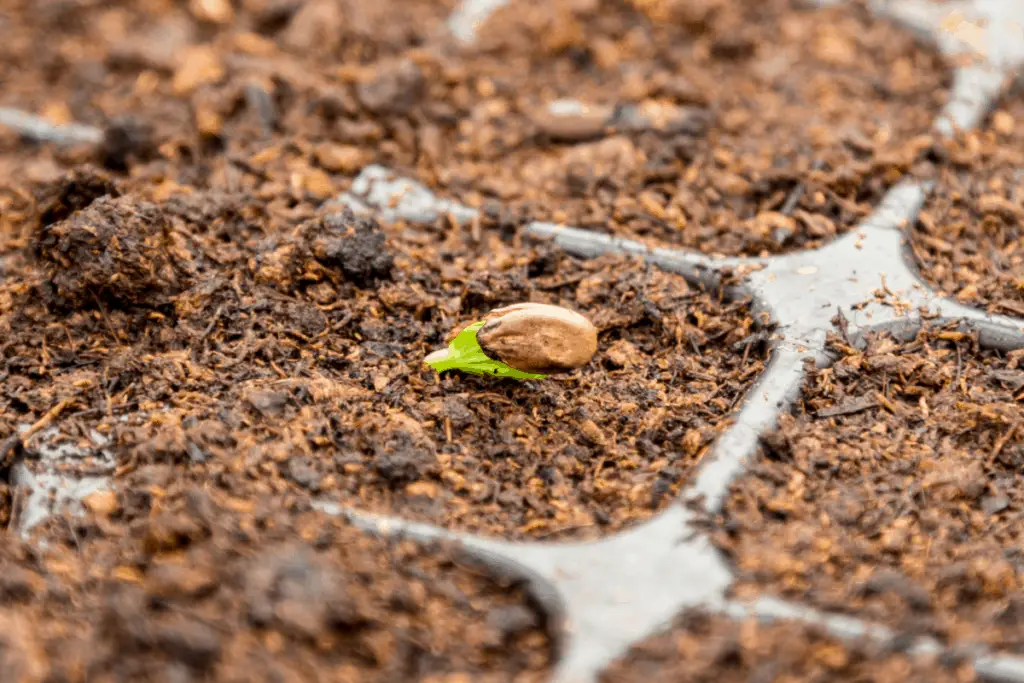
Now you need to place these containers inside the house and in a sunny spot. Keep these containers damp by continuously spraying water on them. Moreover, you also need to cover all of these seeds with a layer of coarse vermiculite.
The main goal of using a vermiculite layer is to increase water and nutrient retention. This coarse vermiculite is capable of aerating the soil, resulting in healthier and more powerful plants. Therefore, it is recommended that you use this layer for potting and repotting the Camellia sinensis.
This will help them absorb and hold as much moisture as they can and make sure the entire process of germination goes as smoothly as possible. Once you have placed the vermiculite layer over the seeds, you need to keep this layer damp.
Keep these containers inside in the sunny environment for at least eight weeks and regularly check the vermiculite layer to make sure that it is damp. After eight weeks, remove the vermiculite layer and check if the seeds have germinated.
How can you make sure that these seeds are germinated? Well, if they are properly germinated, you will see:
- Small roots
- A couple of sprouts
Suppose you do not see any growth, no need to fret. Some seeds may take a longer time than others to germinate properly and show results. So, you need to keep them covered and keep spraying water on them to keep them damp.
Keep checking to make sure that they are properly germinating. Once all of your seeds have been germinated, the next step is to plant them in the proper pots.
Step #4: Cultivate the Camellia Sinensis Shrubs
The next step in successfully growing the Camellia sinensis is to cultivate the shrub and plant the seeds in proper pots.
Camellia sinensis prefers an ericaceous soil in a warm, protected, shady spot. The soil should be free to drain, and plants in a pot is a perfect way to create a domestic tea plantation even in the smallest gardens.
These tea plants can rise to 2 meters in height. If you are thinking of growing several plants in one place, you should always leave a space of 1.5 meters between both plants. When growing this plant in a pot, make sure to leave enough padding on all sides for the roots to grow properly.
The successfully germinated seeds should have shown a few sprouts by now. You may also see a few leaves on the sprouts indicating that it is time to plant them into pots. Once you have enough sprouts, you can start planting these seeds separately into individual pots.
Step #5: Plant the Seeds into Pots
Just make sure that the pot is filled with acidic soil that is currently at a pH range of 6 or 6.5.
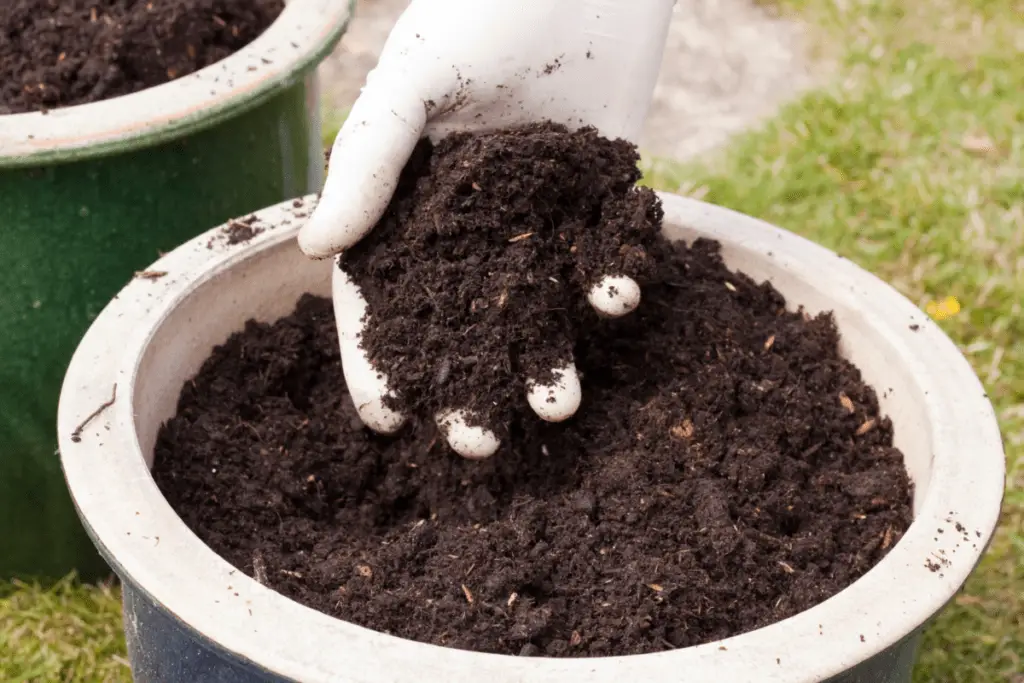
Previously, you kept the containers in a sunny spot to properly germinate the seeds.
However, in this step, you need to make sure that you keep the pots in a:
- Warm place
- Shaded place
- Out of sunlight
You also need to make sure that you keep spraying water onto the acidic soil to keep the pots moist and damp at all times. This will help properly nourish the plants.
Another thing you need to keep in mind while planting the seeds is to make sure that the weather isn’t too cold or freezing. The Camellia sinensis is perennial by nature. This means that this shrub can be planted throughout the year.
These plants can easily stand a little bit of cold, but professionals recommend planting the Camellia sinensis in spring or fall for amazing results. Extremely cold temperatures can hinder the proper growth of tea plants, and you will be left with suffocated and weak tea leaves.
However, you cannot just choose any pot you want and plant these seeds as you please.

There are a few tips that can help you plant the seeds in the best way possible.
- First of all, you need to make sure that you choose the right pot for planting the seeds. This means that the chosen pot should have a lot of holes and should be larger than the expected size of the roots of Camellia sinensis. This way, the size of the pot will allow the plant to grow as much as possible before repotting.
- Moreover, these drainage holes will make sure that the plant does not have to go through the disastrous consequences of waterlogged soil.
- The next thing that you need to do is fill the bottom third of the pot with acidic soil. Moreover, you also need to ensure that you are planting the seed right in the middle of the soil. This will ensure that the roots can grow equally in all directions.
- Once you have planted the seeds, you need to place this pot in a sunny place, such as near a window, etc.. When you are constantly watering the plants, you need to make sure that you actually allow the top 4 inches of the soil to dry up before watering the plant again.
- The goal here is to keep the soil damp and not filled with water. The water should not sit in the pot, or it will damage the roots.
Step #6: Re-pot the Plants Regularly
Some people make the mistake of planting the seeds once and never trying to repot the plant. If you want to make sure that the Camellia sinensis goes through a stage of proper growth, you need to constantly repot the plants when they reach 8 inches or 20 cm in height.
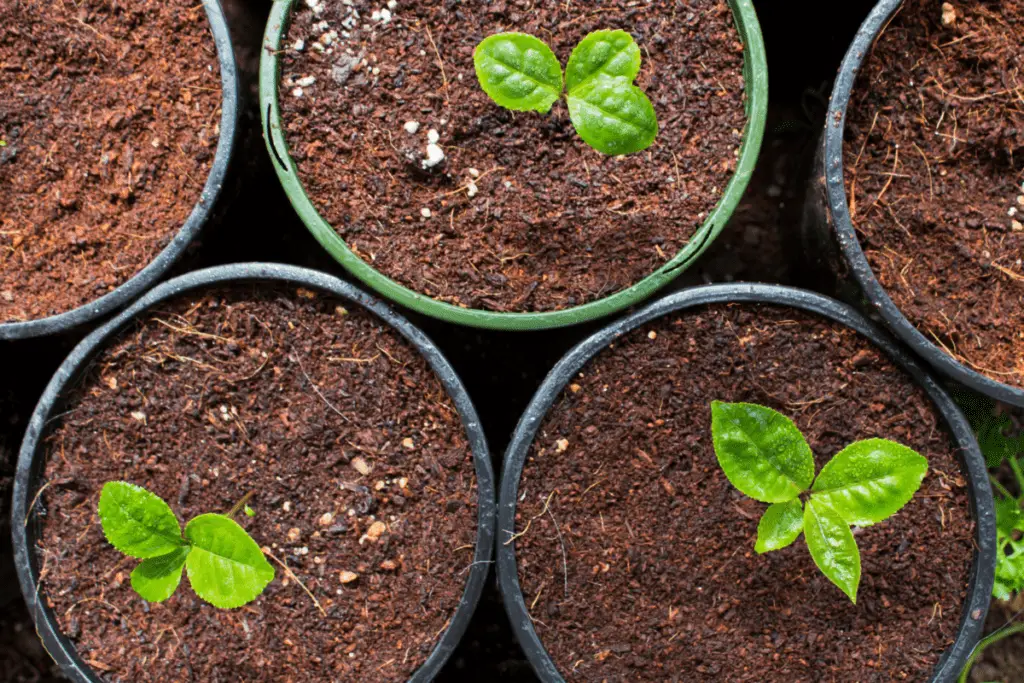
Moreover, when you are repotting the plants, you need to make sure that the next pot is much bigger to accommodate bigger root growth. This way, the roots of the plant will not be suffocated, and the Camellia sinensis will be able to grow as much as possible.
As discussed earlier, you need to keep spraying water to keep the soil damp and moist.
One of the most important things you need to understand about planting Camellia sinensis is that these tea plants require constant hydration. Therefore, you need to constantly water these plants with soft water and also make sure that the acidity remains between the ideal levels of 6 to 6.5.
If you live in an area where the cold, harsh weather can attack the plants. This is why you need to make sure to move the plants to a warmer area inside the house, and keep the temperature above 0 degrees Celsius and Fareneheit.
How Can You Take Care of Camellia Sinensis in the Winter Season?
During the winter, you can offer your tea plant a bright and warmer site about 40 to 60 degrees Fahrenheit (5 to 15 degrees Centigrade). This would need a bit of cover from the direct sun throughout the day, so you need to position the plant where the shade would take place in the afternoon. You may even allow it to sit in the light unless you let it baked in the harsh heat by a south window.
How Can You Harvest the Tea Leaves from Camellia Sinensis?
I’m somewhat impatient. If you are as well, you’ll need to prepare yourself for the timeframe it takes to grow Camellia sinensis.
Please don’t think that you can plant the Camellia sinensis and start harvesting tea leaves within a few weeks. This will be a labor of love, and you may be surprised to find out that it takes at least a few years for the plant to mature properly and offer powerful enough leaves to be harvested for tea.
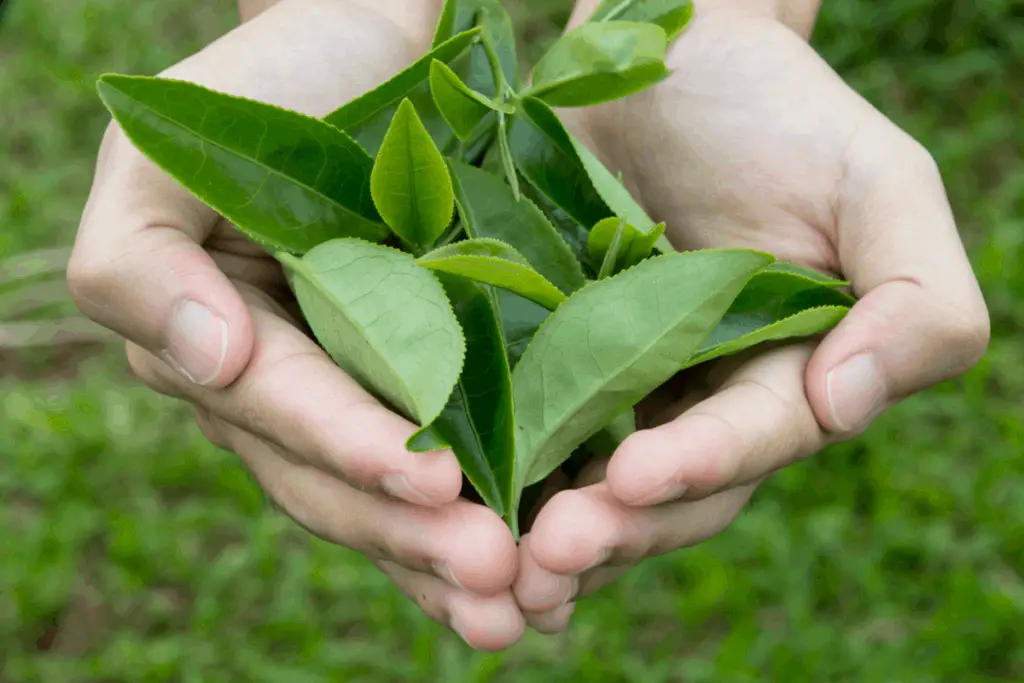
Growing the plant is only the first half of your journey. Harvesting and extracting tea leaves is the second half.
Since you are using Camellia sinensis, you can extract three different kinds of tea from this plant, such as:
- Black Tea
- Green Tea
- Oolong Tea
Let’s take a look at how to properly extract and harvest tea leaves in order to get your favorite kind of tea.

How Can You Harvest Tea Leaves for Black Tea?
If your favorite kind of tea is the black tea, there are a few steps that you can follow in order to extract the tea leaves from your Camellia sinensis plant properly.
- You need to turn your attention to the youngest leaves and leaf buds and pluck them for making robust and tasty black tea.
- Once you have plucked these leaves, you can just roll these youngest leaf buds between your hands to crush them. Make sure to crush them as long as they start to darken and turn red.
- Once these leaves have started to darken, the next step is to lay them down on a tray and place them in a cool location. Let them be cold for a minimum of 2 to 3 days.
- Finally, you can pull them out and start drying them in the oven. Make sure to use a temperature of 250 F for about 20 minutes.
- Once these leaves have been dried, you can just pick them up and store them in an air-tight container.
The new leaves will soon start to replace the youngest leaf buds that you have plucked for black tea. You will be able to extract and harvest the new tea leaves as soon as the previous batch runs out.
How Can You Harvest Tea Leaves for Green Tea?
If you love green tea, here are some steps that you can take in order to extract the tea leaves from Camellia sinensis.
- The very first thing that you need to do is identify the youngest leaves and buds and pluck them from the branches.
- Once you have plucked these leaves, you can blot them dry and let them hang in the shade for a minimum of 8 hours.
- Once they have dried in the shade, you can just steam these leaves on your kitchen stove, or you can also roast these leaves for a different kind of green tea flavor. The choice is yours.
- Once you have steamed or roasted the tea leaves, you can just lay them out on a baking sheet.
- Let these tea leaves heat up in the oven at 250 F for 30 minutes.
- Lastly, you can pull this out of the oven and keep them secure in an air-tight container.
How Can You Harvest Tea Leaves for Oolong Tea?
Lastly, if you love oolong tea, the following steps may be helpful in order to extract the tea leaves from the Camellia sinensis.
- The very first thing that you need to do is identify and isolate the youngest leaves and leaf buds and pluck them from the branches.
- Then, you have to lay them out in some paper, cloth or towel, and wrap them up gently.
- Then, you have to leave them under the sun, let them heat up for about 1 hour. This is often known as withering.
- Once the leaves have wilted enough, you can bring them inside the house and let them cool down to the room temperature for at least 8 hours.
- While these leaves are reaching the room temperature and cooling down, you need to keep on stirring them.
- You will notice that the edges of the leaves will turn red as they start drying up.
- Once the leaves have reached the room temperature and have completely dried up, you can lay them down on a baking sheet and heat them up in the oven at 250 F for half an hour.
- In the end, you can keep these secure in an air-tight container.
Additional Tips from American Camellias Experts
Growing Camellia sinensis in your own home or garden is still an evolving practice, but the experts at AmericanCamellias.com have some extremely helpful firsthand tips.
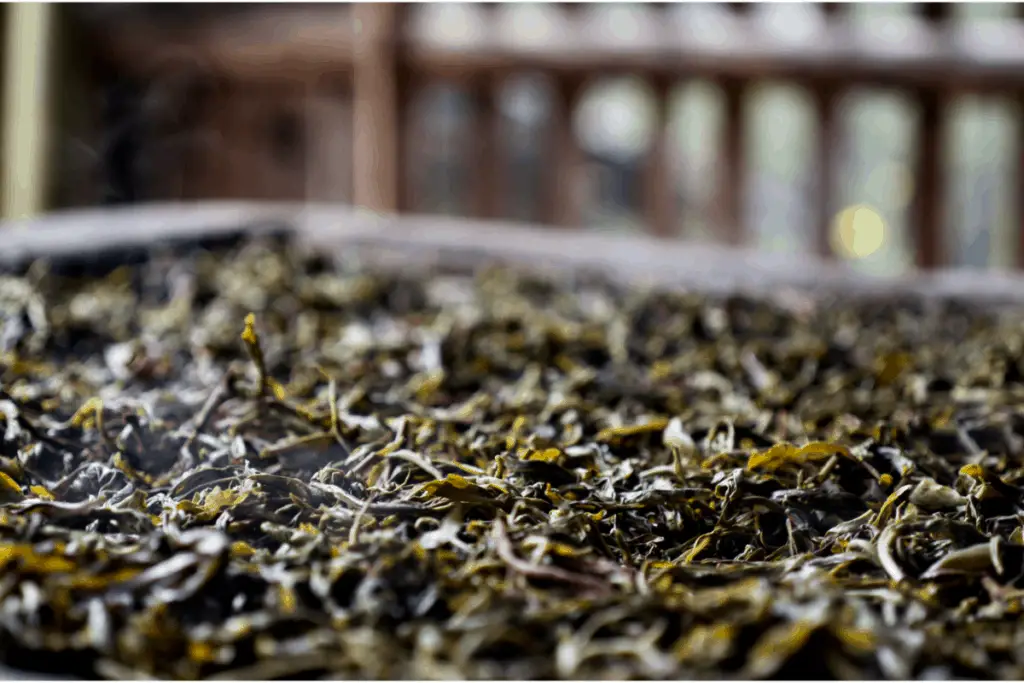
Here is an excerpt:
“Most black tea consumed in the United States is harvested and processed using machines. But many of the finest teas in the world are still picked and processed by hand.
Pinching the tender stems of new growth, pick a few young leaves and leaf buds from your plant, choosing smaller leaves for green tea and larger, older leaves for oolong or black tea. White teas sometimes use just the bud. Tea can be harvested as soon as it starts to grow in the spring, (April or May in our part of North Carolina). A rule of thumb is to pluck the last two leaves and a bud of the growing stem. Leaves will grow back, and you should be able to harvest more in a week or two. Harvested tea should be processed soon after you pick it, but first leaves can be left spread out on a dish or tray to wither for several hours or overnight.
Next, the oxidation process, sometimes called the fermentation of the leaf, is what makes green, oolong and black teas different. Oxidation is what you see when a cut apple turns brown after exposed to the air. Oxidation of tea leaves produces the subtle chemical changes responsible for the distinctive taste and color characteristics of different types of tea. Green tea is not oxidized at all, and can have a grassy or earthy flavor. To prevent oxidation from occurring when processing green tea, steam the leaves or stir fry them in a dry pan for one or two minutes on the stove as you would a vegetable.
Oolong tea is partially oxidized, which often adds a floral or fruity flavor to the tea. To make oolong, bruise the leaves by gently rolling them in your hands or by shaking or pressing them. Let them sit until the leaves just begin to turn brown (30 minutes to a few hours). For black tea, firmly roll and bruise the leaves so that juices are released. Let the leaves sit until they are completely brown (several hours). Oxidation takes place best in an environment that is somewhat warm and not too dry. I sometimes place the leaves on a damp towel and put them in a slightly warmed oven with the heat off.
Rolling and shaping the leaves is optional but, in addition to providing the bruising necessary for oolong and black tea, it achieves a desired look and allows flavors to infuse the hot water differently than they do with unshaped leaves. Spread the leaves on a baking sheet and dry in the oven at 200-250 degrees for 20 minutes or until dry. Enjoy the aroma of the drying leaves! Dried tea can be stored in an airtight container away from the light. To get the best taste from your fresh teas, use within three to six months.”
What Are the Specifics of Camellia Sinensis? Basic Facts
Now that you know the specific steps for growing your own tea plant, let’s take some time to go over some basic facts about the plant.

Here are some interesting facts you may want to know:
- The tea plant can measure up to 55 feet (17 m) in the wild but is thoroughly pruned to help harvest, generally producing a shrub about 4-6 feet (1 or 2 m) tall.
- This tea plant offers small but pretty white flowers. These flowers often resemble small magnolias, with yellow stamens. It is a similar relative to camellia, the C. japonica, which is sometimes twice as wide and beautiful, in purple, red, or white flowers. Nonetheless, you would definitely love the presentation if your tea plant ever blooms.
- The tea we consume comes from their leaves: the same leaves may provide green tea, white tea, Black Tea, Oolong Tea, etc. according to the treatment.
- The tea plant can only be cultivated as a house plant for gardeners in temperate climes. You should probably place it outdoors for the season, but before winter, you have to have it indoors.
- There are few select hardy strains that survive in the USDA hardiness zone 7 (AgCan zone 8) protected areas, but in general, you have to stay in subtropical climate (zone 9).
- The tea plant will produce beautiful foliage with its glossy dark green leaves and finely dented edges. You can definitely love little white flowers in your bloom, but it would usually take many years before a tea plant develops, at least under standard conditions at home.
- Moreover, the Camellia sinensis can never bloom if you harvest too vigorously to remove new production periodically. Therefore, you also need to grow a few plants in order to maintain a steady growth of tea leaves.
- On small stalks, the leaves are dark grey, lanceolate or elliptic. They are typically 5-10 cm (2-4 inches) thick, rigid at the peak of the bottom with narrow tightening margins. Youthful seeds, though glabrous, are hairy.
- On small branchlets in the leaf axils, the flowers with a collection of yellow stamens are solo or two or three. They grow on thin stalks with several tiny bracts, around 2.5 to 4 cm long. They ‘re a little bit bigger.
- Flowers with a diameter of up to 4 cm (1.5) “shaped by five to nine white petals, often rose, irregular, slightly rounded, concave. The petals are formed by five imbricated sepals that are partially joined forward, flat and continuous, ovate or oval.
- The buds bloom before the fruit achieves maximum maturity for up to one year. The fruit is a smooth, flattish, rounded capsule divided into one to five chambers with a single seed in each chamber.
- The Camellia sinensis is a beautiful glossy green plant growing indoors to approximately 60 cm (24 inches) or higher and usually requires minimal attention. As the name implies, the processed young leaves of the plant yield commercial tea, in part, has become a popular indoor species.
- Even if you grow one Camellia sinensis indoors, it will not generate a great deal of tea. Therefore, you need to grow a lot of plants at the same time to maximize the output of the leaves.
- If adequate growth is achieved to allow future shoots to develop, these young leaves can naturally be dried by the sun. When these leaves are dry, they can be rubbed gently between their hands to create tea leaves. Tea is claimed to be of the finest standard when manufactured from tea leaves used immediately and not months after drying.
If the tea does not come from the Camellia sinensis plant, it is not actually considered tea. While there are a lot of brands out there that combine flowers and herbs and other extracts, the actual tea still comes from the Camellia sinensis plant.
While there is more than one way of growing the Camellia sinensis plant, the difference in the taste of the tea comes from the way, and the procedure that is used to grow this plant. Moreover, the quality of the soil surrounding the seeds and the roots also has an impact on the taste of the tea.
There are not many variations in the taste of the tea. However, due to modern advancements, a lot of manufacturers actually treat the tea leaves in order to create artificial flavors.
More often than not, these treatment plans include the addition of:
- Oil
- Smoking
- Chemical flavors
The very first cup of tea was brewed around 2,000 years ago when an ancient Chinese emperor left some leaves in a pot of boiling water overnight. This is considered to be the very first cup of tea.
The tea leaves and extracts from the Camellia sinensis plant also offer a wide range of health benefits to the drinkers. According to a recent study, people who drink more than 375 ml of black tea on a daily basis actually observed a 43% reduction in the risk of having cardiac problems. Moreover, these extracts also proved to be extremely positive in reducing the risk of having a heart attack by 70% among drinkers.
The topmost regions for the best Camellia sinensis plant are:
- India
- China
- Taiwan
- Africa
- Sri Lank
For some people, tea takes the lead over coffee when it comes to relaxing after a long day or starting the day with an energetic vibe.
You can choose from a number of options depending upon your preference, and all of these options will offer an amazing boost for the day, and health benefits in the long run.
From the basic preparation of seeds to the final harvesting, if you strictly adhere to the tips from professionals, you can easily master the art of harvesting full and robust tea leaves for an amazing cup of tea.

